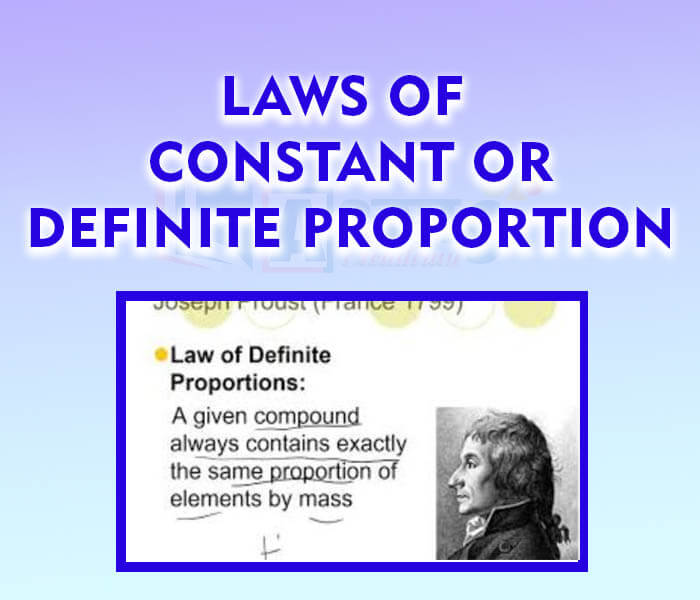Law of Constant or Definite Proportion







Law of Constant or Definite Proportion
Law of Constant Proportions or Law of Definite Proportions: French chemist, Joseph Proust analysed the chemical composition (types and percentage of elements present) of a large number of compounds and came to the conclusion that the proportion of each element in a compound is constant (or fixed), irrespective of where the compound came from or who prepared it. On this basis he proposed the law of constant proportions, according to which “In a chemical substance (or compound), the elements are always present in definite proportions (or ratios) by mass.”
Example: In a compound such as water, the ratio of the mass of hydrogen to the mass of oxygen is always 1: 8, whatever the source of water. Thus, if 9 g of water is decomposed, 1 g of hydrogen and 8 g of oxygen are always obtained. Similarly, carbon dioxide () always contains carbon and oxygen in the ratio of 3: 8. If a sample of
contains 36 g of carbon then it is compulsory that the sample has 96 g Oxygen.
Example: Copper oxide was prepared by two different methods. In one case, 1.75 g of the metal gave 2.19 g of oxide. In the second case, 1.14 g of the metal gave 1.43 g of the oxide. Show that the given data illustrate the law of constant proportions.
Case l : Mass of copper = 1.75 g And mass of copper oxide = 2.19 g.
So, mass of oxygen = Mass of copper oxide — Mass of copper = 2.19 — 1.75 = 0.44g
Now, in first sample of copper oxide compound. Mass of copper : Mass of oxygen = 1.75 : 0.44 = 3.98 : 1 = 4: 1
Case 2: Mass of copper = 1.14g And mass of copper oxide = 1.43 g.
So, mass of oxygen = Mass of copper oxide — Mass of copper = 1.43 — 1.14 = 0.29g
Now, in second sample of copper oxide compound. Mass of copper : Mass of oxygen
=1.14:0.29 = 3.93:1 =4 : 1
From the above calculations we can see that the ratio (or proportion) of copper and oxygen elements in the two samples of copper oxide compound is the same, i.e. 4: 1. So, the given data verify the law of constant proportions.
| ELEMENT | SYMBOL | ATOMIC NUMBER | ATOMIC MASS |
| HYDROGEN | H | 1 | 1 |
| HELIUM | He | 2 | 4 |
| CARBON | C | 6 | 12 |
| NITROGEN | N | 7 | 14 |
| OXYGEN | O | 8 | 16 |
| FLUORINE | F | 9 | 19 |
| SODIUM | Na | 11 | 23 |
| MAGNESIUM | Mg | 12 | 24 |
| SULPHUR | S | 16 | 32 |
| CHLORINE | Cl | 17 | 35 |
In a compound such as water, the ratio of the mass of hydrogen to the mass of oxygen is always 1: 8, whatever the source of water. If 27 g of water is decomposed, then how much grams of hydrogen we get ? | |||
| Right Option : C | |||
| View Explanation | |||
The percentage by weight of | |||
| Right Option : C | |||
| View Explanation | |||
In a compound such as water, the ratio of the mass of hydrogen to the mass of oxygen is always 1: 8, whatever the source of water. If 18 g of water is decomposed, then how much grams of oxygen we get ? | |||
| Right Option : B | |||
| View Explanation | |||
Students / Parents Reviews [20]
It was a good experience with Abhyas Academy. I even faced problems in starting but slowly and steadily overcomed. Especially reasoning classes helped me a lot.

Cheshta
10thAbhyas academy is great place to learn. I have learnt a lot here they have finished my fear of not answering.It has created a habit of self studying in me.The teachers here are very supportive and helpful. Earlier my maths and science was good but now it has been much better than before.

Barkha Arora
10thIn terms of methodology I want to say that institute provides expert guidence and results oriented monitering supplements by requsite study material along with regular tests which help the students to improve their education skills.The techniques of providing education helps the students to asses...

Aman Kumar Shrivastava
10thI have spent a wonderful time in Abhyas academy. It has made my reasoning more apt, English more stronger and Maths an interesting subject for me. It has given me a habbit of self studying

Yatharthi Sharma
10thOne of the best institutes to develope a child interest in studies.Provides SST and English knowledge also unlike other institutes. Teachers are co operative and friendly online tests andPPT develope practical knowledge also.

Aman Kumar Shrivastava
10thAbhyas is an institute of high repute. Yogansh has taken admission last year. It creates abilities in child to prepare for competitive exams. Students are motivated by living prizes on basis of performance in Abhyas exams. He is satisfied with institute.

Yogansh Nyasi
7thAbhyas Methodology is very good. It is based on according to student and each child manages accordingly to its properly. Methodology has improved the abilities of students to shine them in future.

Manish Kumar
10thAbhyas is a complete education Institute. Here extreme care is taken by teacher with the help of regular exam. Extra classes also conducted by the institute, if the student is weak.

Om Umang
10thThird consective year,my ward is in Abhyas with nice experience of admin and transport support.Educational standard of the institute recumbent at satisfactory level. One thing would live to bring in notice that last year study books was distributed after half of the session was over,though study ...

Ayan Ghosh
8thAbhyas institute is one of the best coaching institute in the vicinity of Ambala Cantt area. The teachers of the institute are well experienced and very helpful in solving the problems of the students.The good thing of the institute is that it is providing extra classes for the students who are w...

Aman Kumar Shrivastava
10thIt has a great methodology. Students here can get analysis to their test quickly.We can learn easily through PPTs and the testing methods are good. We know that where we have to practice

Barkha Arora
10thUsually we see institutes offering objective based learning which usually causes a lag behind in subjective examinations which is the pattern followed by schools. I think it is really a work of planning to make us students grab the advantages of modes of examination, Objective Subjective and Onli...

Anika Saxena
8thMy experience with Abhyas academy is very nice or it can be said wonderful. I have been studying here from seven class. I have been completing my journey of three years. I am tinking that I should join Abhyas Academy in tenth class as I am seeing much improvement in Maths and English

Hridey Preet
9thThe experience was nice. I studied here for three years and saw a tremendous change in myself. I started liking subjects like English and SST which earlier I ran from. Extra knowledge gave me confidence to overcome competitive exams. One of the best institutes for secondary education.

Aman Kumar Shrivastava
10thMy experience was very good with Abhyas academy. I am studying here from 6th class and I am satisfied by its results in my life. I improved a lot here ahead of school syllabus.

Ayan Ghosh
8thWhen I have not joined Abhyas Academy, my skills of solving maths problems were not clear. But, after joining it, my skills have been developed and my concepts of science and SST are very well. I also came to know about other subjects such as vedic maths and reasoning.

Sharandeep Singh
7thMy experience with Abhyas academy is very good. I did not think that my every subject coming here will be so strong. The main thing is that the online tests had made me learn here more things.

Hiya Gupta
8thAbhyas institute is one of the best coaching institute in the vicinity of Ambala cantt.The institute provides good and quality education to the students.The teachers are well experienced and are very helpful in solving the problems. The major advantages of the institute is extra classes for weak...

Shreya Shrivastava
8thMy experience with Abhyas is very good. I have learnt many things here like vedic maths and reasoning also. Teachers here first take our doubts and then there are assignments to verify our weak points.

Shivam Rana
7thIt was good as the experience because as we had come here we had been improved in a such envirnment created here.Extra is taught which is beneficial for future.
